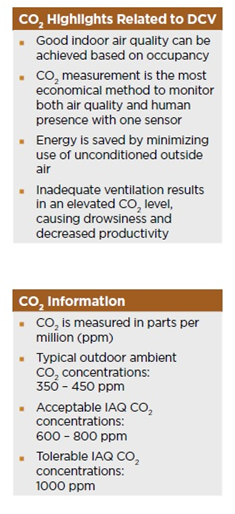Optimizing Demand Controlled Ventilation (DCV)
Optimizing demand controlled ventilation (DCV) will contribute to an enhanced indoor environment at lower operating costs. The system can only be optimized by accurate carbon dioxide (CO2) sensing.

Humans spend 90 % of their time indoors. Studies indicate that indoor air quality (IAQ) is directly linked to human well-being and productivity. The CO2 level can be used as an indicator for indoor human presence. A high CO2 level is a sign of poor ventilation and often an indication of other unpleasant odors in the air. As many as 30 % of buildings have poor IAQ.
The most economical way to determine the ventilation demand is to measure carbon dioxide, which increases in relation to number of humans present. By controlling ventilation according to the CO2 level rather than the assumed amount of people occupying the space, the indoor air can be kept fresh without over-ventilating and wasting energy.
Industry Drivers
Limits for CO2 levels in indoor air differ slightly from one country to another. For example, interpretation of ASHRAE (www.ashrae.org) Standard 62.1 “Ventilation for Acceptable Indoor Air Quality” implies CO2 levels should not exceed 700 ppm above outdoor ambient levels of 400 ppm. The EU Commission has issued an Energy Performance in Buildings Directive (2002/91/EC) which specifies that energy savings should not have a negative impact on indoor air quality.
Energy savings as stated by the ETIAQ (Energy Technologies and Indoor Air Quality) project coordinated by Rehva, the Federation of European HVAC Associations, reports 20-50 % energy savings in public buildings using DCV, and even greater savings potential in buildings with varying occupancy.
Linking CO2 Performance to DCV Systems
Green building initiatives, such as LEED (www.usgbc.org) Rating Systems, specify action to be taken when CO2 conditions vary by 10% or more from the user specific set point. Either the building automation system will generate an automatic alarm and adjust the ventilation accordingly or an alert must be generated to the building occupants.
The stability of the ventilation system is typically checked and adjusted only during commissioning. Once in place, CO2 transmitters are expected to operate continuously for at least five years. Therefore, the selection of CO2 technology is not only important for initial accuracy specifications, but for stability, too. Maintaining IAQ standards can be challenging while striving for energy efficiency.
Most CO2 sensor manufacturers will offer an initial accuracy specification in the range of ±50 to 100 ppm at concentrations levels of 1000 ppm. If the system is set to maintain < 800 ppm CO2 level in the space and the error of the sensor is 80 ppm, the deviation could lead to false alarms. If the CO2 level indication is too low, it will be limiting the amount of fresh air. If the CO2 level indication is too high, it will be introducing more unconditioned outdoor air to the space than is required. The situation is likely to worsen over time, if the sensor has poor long-term stability.
IAQ without False Alarms
Every technology has some component that is depleting or changing, which makes it difficult to maintain the required accuracy specifications for the application. The most common technology on the market for measuring CO2 is the non-dispersive infrared (NDIR) technology. The problems with this technology are the required light source that will lose its intensity over time and the inability to identify when contamination of the light path has occurred.
Vaisala’s CARBOCAP® has a unique capability that measures at alternating dual-wavelengths: one wavelength to measure CO2 and a second reference wavelength to determine the light source intensity and contaminant levels. The result is accuracy that lasts for years without having to rely on self-calibration techniques to perform a light source calibration.
One Technology fits all HVAC Applications
By eliminating the need for self calibration, the Vaisala CARBOCAP® sensor can be used in a wider variety of applications including variable outdoor CO2 levels or facilities with around-the-clock occupancy e.g. hospitals, workplaces, residential buildings, homes for the elderly.
Thanks to the robust CARBOCAP technology, the sensor in the duct mount products is truly located in the duct. Other CARBOCAP® benefits include tolerance to water condensation, and good temperature tolerance allowing use in refrigeration applications. Visit Vaisala (www.vaisala.com/CO2) to learn more about the complete CO2 offering.
Source: Vaisala

